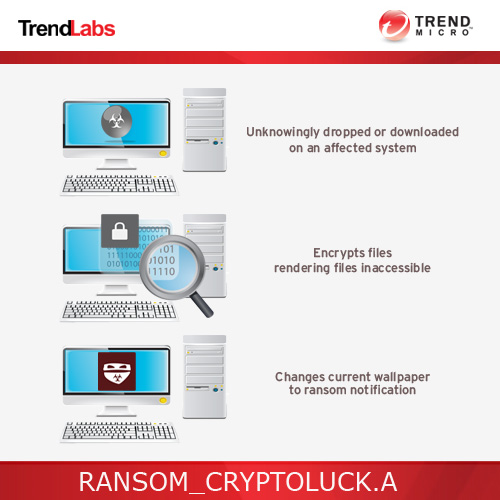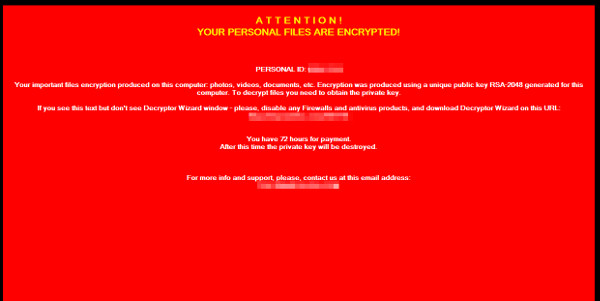RANSOM_CRYPTOLUCK.A
Trojan.Win32.Deshacop.daw (Kaspersky), Ransom:Win32/Crituck.A (Microsoft), Win32/Filecoder.CryptoLuck.A (ESET-NOD32)
Windows


Threat Type: Trojan
Destructiveness: No
Encrypted:
In the wild: Yes
OVERVIEW
This malware is a new family of ransomware discovered on early November 2016. Users affected by this particular ransomware may find their files and documents rendered inaccessible.
To get a one-glance comprehensive view of the behavior of this Trojan, refer to the Threat Diagram shown below.

This Trojan may be unknowingly downloaded by a user while visiting malicious websites. It may be manually installed by a user.
It connects to certain websites to send and receive information. It terminates itself if it detects it is being run in a virtual environment.
TECHNICAL DETAILS
Arrival Details
This Trojan may be unknowingly downloaded by a user while visiting malicious websites.
It may be manually installed by a user.
Installation
This Trojan drops the following component file(s):
- {path of encrypted files}\@WARNING_FILES_ARE_ENCRYPTED.{victim id}.txt ← ransom note
- %Application Data%\76ff\crp.cfg ← configuration file
- %Application Data%\76ff\goopdate.ini ← ransom note
(Note: %Application Data% is the Application Data folder, where it usually is C:\Documents and Settings\{user name}\Application Data on Windows 2000, Windows Server 2003, and Windows XP (32- and 64-bit); C:\Users\{user name}\AppData\Roaming on Windows Vista (32- and 64-bit), Windows 7 (32- and 64-bit), Windows 8 (32- and 64-bit), Windows 8.1 (32- and 64-bit), Windows Server 2008, and Windows Server 2012.)
It drops and executes the following files:
- %Application Data%\76ff\GoogleUpdate.exe ← loader
- %Application Data%\76ff\goopdate.dll ← encryptor (Ransom_CryptoLuck.A)
(Note: %Application Data% is the Application Data folder, where it usually is C:\Documents and Settings\{user name}\Application Data on Windows 2000, Windows Server 2003, and Windows XP (32- and 64-bit); C:\Users\{user name}\AppData\Roaming on Windows Vista (32- and 64-bit), Windows 7 (32- and 64-bit), Windows 8 (32- and 64-bit), Windows 8.1 (32- and 64-bit), Windows Server 2008, and Windows Server 2012.)
It creates the following folders:
- %Application Data%\76ff
(Note: %Application Data% is the Application Data folder, where it usually is C:\Documents and Settings\{user name}\Application Data on Windows 2000, Windows Server 2003, and Windows XP (32- and 64-bit); C:\Users\{user name}\AppData\Roaming on Windows Vista (32- and 64-bit), Windows 7 (32- and 64-bit), Windows 8 (32- and 64-bit), Windows 8.1 (32- and 64-bit), Windows Server 2008, and Windows Server 2012.)
It adds the following mutexes to ensure that only one of its copies runs at any one time:
- CryptoLuck_Instance
Autostart Technique
This Trojan adds the following registry entries to enable its automatic execution at every system startup:
HKEY_CURRENT_USER\Software\Microsoft\
Windows\CurrentVersion\Run
GoogleUpdate.exe = "%Application Data%\76ff\GoogleUpdate.exe"
Other System Modifications
This Trojan adds the following registry keys:
HKEY_CURRENT_USER\Software\sosad_{victim id}
HKEY_CURRENT_USER\Software\sosad_{victim id}
conf = {config file}
HKEY_CURRENT_USER\Software\sosad_{victim id}\
files
{full filename of encrypted files} = {flag}
Other Details
This Trojan connects to the following website to send and receive information:
- http://{BLOCKED}ares.top/two/index.php
It encrypts files with the following extensions:
- .3ds
- .3fr
- .4db
- .4dd
- .7z
- .7zip
- .accdb
- .accdt
- .aep
- .aes
- .ai
- .apk
- .arch00
- .arj
- .arw
- .asset
- .bar
- .bay
- .bc6
- .bc7
- .big
- .bik
- .bkf
- .bkp
- .blob
- .bpw
- .bsa
- .cas
- .cdr
- .cer
- .cfr
- .cr2
- .crp
- .crt
- .crw
- .csv
- .d3dbsp
- .das
- .dazip
- .db0
- .dba
- .dbf
- .dbx
- .dcr
- .der
- .desc
- .dmp
- .dng
- .doc
- .docm
- .docx
- .dot
- .dotm
- .dotx
- .dwfx
- .dwg
- .dwk
- .dxf
- .dxg
- .eml
- .epk
- .eps
- .erf
- .esm
- .fdb
- .ff
- .flv
- .forge
- .fos
- .fpk
- .fsh
- .gdb
- .gho
- .gpg
- .gxk
- .hkdb
- .hkx
- .hplg
- .hvpl
- .ibank
- .icxs
- .idx
- .ifx
- .indd
- .iso
- .itdb
- .itl
- .itm
- .iwd
- .iwi
- .jpe
- .jpeg
- .jpg
- .js
- .kdb
- .kdbx
- .kdc
- .key
- .kf
- .ksd
- .layout
- .lbf
- .litemod
- .lrf
- .ltx
- .lvl
- .m2
- .map
- .max
- .mcmeta
- .mdb
- .mdbackup
- .mddata
- .mdf
- .mef
- .menu
- .mlx
- .mpd
- .mpp
- .mpqge
- .mrwref
- .msg
- .myo
- .nba
- .nbf
- .ncf
- .nrw
- .nsf
- .ntl
- .nv2
- .odb
- .odc
- .odm
- .odp
- .ods
- .odt
- .ofx
- .orf
- .p12
- .p7b
- .p7c
- .pak
- .pdb
- .pdd
- .pef
- .pem
- .pfx
- .pgp
- .pkpass
- .ppj
- .pps
- .ppsx
- .ppt
- .pptm
- .pptx
- .prproj
- .psd
- .psk
- .pst
- .psw
- .ptx
- .py
- .qba
- .qbb
- .qbo
- .qbw
- .qdf
- .qfx
- .qic
- .qif
- .r3d
- .raf
- .rar
- .raw
- .rb
- .re4
- .rgss3a
- .rim
- .rofl
- .rtf
- .rw2
- .rwl
- .saj
- .sav
- .sb
- .sdc
- .sdf
- .sid
- .sidd
- .sidn
- .sie
- .sis
- .sko
- .slm
- .snx
- .sql
- .sr2
- .srf
- .srw
- .sum
- .svg
- .sxc
- .syncdb
- .t12
- .t13
- .tar
- .tax
- .tbl
- .tib
- .tor
- .txt
- .upk
- .vcf
- .vcxproj
- .vdf
- .vfs0
- .vpk
- .vpp_pc
- .vtf
- .w3x
- .wallet
- .wb2
- .wdb
- .wotreplay
- .wpd
- .wps
- .x3f
- .xf
- .xlk
- .xls
- .xlsb
- .xlsm
- .xlsx
- .xxx
- .zip
- .ztmp
It renames encrypted files using the following names:
- {filename}.{victim id}_luck
It terminates itself if it detects it is being run in a virtual environment.
It does the following:
- It deletes shadow copies by executing the following command:
- vssadmin.exe delete shadows /all /quiet
It terminates itself if windows or classes contain any of the following string(s):
- OLLYDBG
- VBoxTrayToolWnd
- VBoxTrayToolWndClass
- VMDisplayChangeControlClass
- VMwareDragDetWndClass
- VMwareTrayIcon
- vmtoolsdControlWndClass
NOTES:
It changes the wallpaper of the affected system with the following image:

SOLUTION
Step 1
Before doing any scans, Windows XP, Windows Vista, and Windows 7 users must disable System Restore to allow full scanning of their computers.
Step 2
Identify and terminate files detected as RANSOM_CRYPTOLUCK.A
- Windows Task Manager may not display all running processes. In this case, please use a third-party process viewer, preferably Process Explorer, to terminate the malware/grayware/spyware file. You may download the said tool here.
- If the detected file is displayed in either Windows Task Manager or Process Explorer but you cannot delete it, restart your computer in safe mode. To do this, refer to this link for the complete steps.
- If the detected file is not displayed in either Windows Task Manager or Process Explorer, continue doing the next steps.
Step 3
Delete this registry value
Important: Editing the Windows Registry incorrectly can lead to irreversible system malfunction. Please do this step only if you know how or you can ask assistance from your system administrator. Else, check this Microsoft article first before modifying your computer's registry.
- In HKEY_CURRENT_USER\Software\Microsoft\Windows\CurrentVersion\Run
- GoogleUpdate.exe = "%Application Data%\76ff\GoogleUpdate.exe"
- GoogleUpdate.exe = "%Application Data%\76ff\GoogleUpdate.exe"
Step 4
Delete this registry key
Important: Editing the Windows Registry incorrectly can lead to irreversible system malfunction. Please do this step only if you know how or you can ask assistance from your system administrator. Else, check this Microsoft article first before modifying your computer's registry.
- In HKEY_CURRENT_USER\Software
- sosad_{victim id}
- sosad_{victim id}
Step 5
Search and delete these folders
Step 6
Search and delete this file
Step 7
Scan your computer with your Trend Micro product to delete files detected as RANSOM_CRYPTOLUCK.A. If the detected files have already been cleaned, deleted, or quarantined by your Trend Micro product, no further step is required. You may opt to simply delete the quarantined files. Please check this Knowledge Base page for more information.
Step 8
Restore encrypted files from backup.
Did this description help? Tell us how we did.

